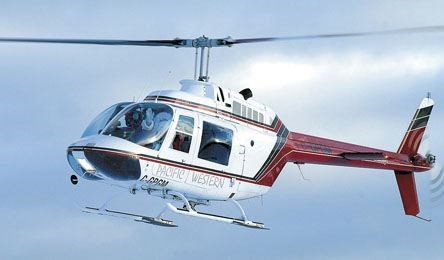Often forgotten in the transportation mix across the region, helicopters play a key role in supporting economic activity but also serve as a warning when business is slowing down.
Helicopters are busy transporting miners, geologists, petroleum personnel, foresters and surveyors around the backcountry of the province when these sectors are enjoying lucrative times. They are parked on the ground, however, when the profit margins grow thin and exploration stops. Helicopters are northern B.C.'s early warning system.
More often than not, helicopters based in Prince George have been parked lately.
"The helicopter industry is in sad shape," said Pete McGill, president and chief pilot at Aberdeen Helicopters. "The resource industry is down. The oil patch is slow because of low oil prices, the mining industry is slow as well because of their lower commodity prices. The money for junior exploration is usually disposable investment money from richer sources and if the economy is down a bit, that money isn't there. As an industry we are pretty dependent on that activity."
Not all the casualties have been verified, said McGill, but he has heard of six helicopter companies in B.C. closing their doors in the past year, including Pacific Western Helicopter based in Prince George.
Attempts to contact Pacific Western Helicopter were unsuccessful.
On the other hand, said McGill, for those companies still turning blades, contraction in the industry can be helpful.
"We are trying to get into tourism more. That helps a bit but it is slow to build up," McGill said. "If you're in a position to go work overseas, you look at that. It's drastic, but companies do that, but that is also dependent on the same global commodity prices. Basically, helicopters are in the air for two things: resource work and disaster work like forest fires. We'd all prefer the first option, if we could choose."
Helicopter demand in the resource sector is linked to more than just commodity dollars. McGill said he has high hopes for the forest industry in this area, but it is a few years out yet. He and his colleagues were busy when the mountain pine beetle epidemic was in full flight, as they flew aerial survey crews and equipment throughout the region scoping the places the pine trees were being devastated. Then, there were flights to map out the harvest plans.
But that is over now, and pine trees are being cut as the priority species now and for the next few years of lumber life still left in those dead pines. But all the cut-blocks are generally mapped out now, and pine grows in generally easier terrain so ground movement is fine for the foresters involved in this mass effort.
When the merchantability of the dead pine trees dwindles, though, attention is going to turn again to other species like balsam and fir, said McGill, and those kinds of trees grow in more challenging terrain - helicopter country.
For those wanting a unique view of the region, McGill and his colleagues are happy to accommodate. The views are never better than from a helicopter but at about $125 per 20 minute ride, he doesn't begrudge the average tourist from looking at different options.
He does explain, though, that the cost of aircraft fuel is high, pilots' and mechanics' wages are paid at special-skill rates, safety regulations are rightly onerous which adds to the cost, and a used helicopter runs anywhere between $1.5 and $3 million let alone the brand new ones.



